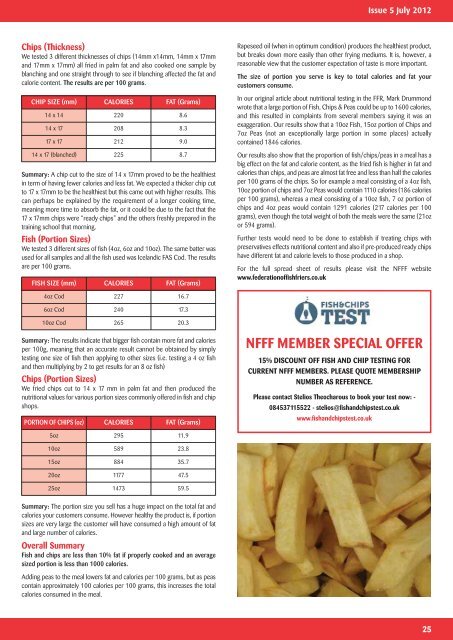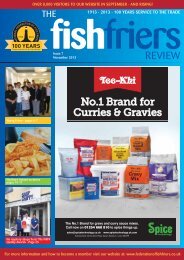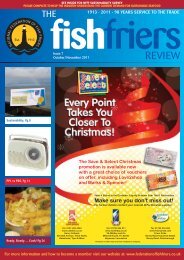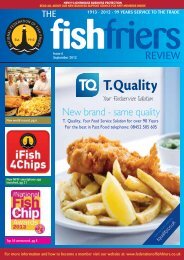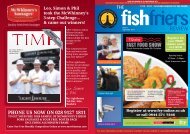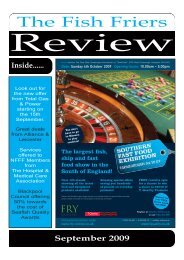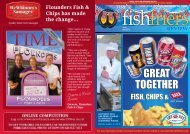Jul 2012 - Issue 5 - National Federation of Fish Friers
Jul 2012 - Issue 5 - National Federation of Fish Friers
Jul 2012 - Issue 5 - National Federation of Fish Friers
Create successful ePaper yourself
Turn your PDF publications into a flip-book with our unique Google optimized e-Paper software.
Chips (Thickness)<br />
We tested 3 different thicknesses <strong>of</strong> chips (14mm x14mm, 14mm x 17mm<br />
and 17mm x 17mm) all fried in palm fat and also cooked one sample by<br />
blanching and one straight through to see if blanching affected the fat and<br />
calorie content. The results are per 100 grams.<br />
CHIP SIZE (mm) CALORIES FAT (Grams)<br />
14 x 14 220 8.6<br />
14 x 17 208 8.3<br />
17 x 17 212 9.0<br />
14 x 17 (blanched) 225 8.7<br />
Summary: A chip cut to the size <strong>of</strong> 14 x 17mm proved to be the healthiest<br />
in term <strong>of</strong> having fewer calories and less fat. We expected a thicker chip cut<br />
to 17 x 17mm to be the healthiest but this came out with higher results. This<br />
can perhaps be explained by the requirement <strong>of</strong> a longer cooking time,<br />
meaning more time to absorb the fat, or it could be due to the fact that the<br />
17 x 17mm chips were “ready chips” and the others freshly prepared in the<br />
training school that morning.<br />
<strong>Fish</strong> (Portion Sizes)<br />
We tested 3 different sizes <strong>of</strong> fish (4oz, 6oz and 10oz). The same batter was<br />
used for all samples and all the fish used was Icelandic FAS Cod. The results<br />
are per 100 grams.<br />
FISH SIZE (mm) CALORIES FAT (Grams)<br />
4oz Cod 227 16.7<br />
6oz Cod 240 17.3<br />
10oz Cod 265 20.3<br />
Summary: The results indicate that bigger fish contain more fat and calories<br />
per 100g, meaning that an accurate result cannot be obtained by simply<br />
testing one size <strong>of</strong> fish then applying to other sizes (i.e. testing a 4 oz fish<br />
and then multiplying by 2 to get results for an 8 oz fish)<br />
Chips (Portion Sizes)<br />
We fried chips cut to 14 x 17 mm in palm fat and then produced the<br />
nutritional values for various portion sizes commonly <strong>of</strong>fered in fish and chip<br />
shops.<br />
PORTION OF CHIPS (oz) CALORIES FAT (Grams)<br />
5oz 295 11.9<br />
10oz 589 23.8<br />
15oz 884 35.7<br />
20oz 1177 47.5<br />
25oz 1473 59.5<br />
Summary: The portion size you sell has a huge impact on the total fat and<br />
calories your customers consume. However healthy the product is, if portion<br />
sizes are very large the customer will have consumed a high amount <strong>of</strong> fat<br />
and large number <strong>of</strong> calories.<br />
Overall Summary<br />
<strong>Fish</strong> and chips are less than 10% fat if properly cooked and an average<br />
sized portion is less than 1000 calories.<br />
Adding peas to the meal lowers fat and calories per 100 grams, but as peas<br />
contain approximately 100 calories per 100 grams, this increases the total<br />
calories consumed in the meal.<br />
<strong>Issue</strong> 5 <strong>Jul</strong>y <strong>2012</strong><br />
Rapeseed oil (when in optimum condition) produces the healthiest product,<br />
but breaks down more easily than other frying mediums. It is, however, a<br />
reasonable view that the customer expectation <strong>of</strong> taste is more important.<br />
The size <strong>of</strong> portion you serve is key to total calories and fat your<br />
customers consume.<br />
In our original article about nutritional testing in the FFR, Mark Drummond<br />
wrote that a large portion <strong>of</strong> <strong>Fish</strong>, Chips & Peas could be up to 1600 calories,<br />
and this resulted in complaints from several members saying it was an<br />
exaggeration. Our results show that a 10oz <strong>Fish</strong>, 15oz portion <strong>of</strong> Chips and<br />
7oz Peas (not an exceptionally large portion in some places) actually<br />
contained 1846 calories.<br />
Our results also show that the proportion <strong>of</strong> fish/chips/peas in a meal has a<br />
big effect on the fat and calorie content, as the fried fish is higher in fat and<br />
calories than chips, and peas are almost fat free and less than half the calories<br />
per 100 grams <strong>of</strong> the chips. So for example a meal consisting <strong>of</strong> a 4oz fish,<br />
10oz portion <strong>of</strong> chips and 7oz Peas would contain 1110 calories (186 calories<br />
per 100 grams), whereas a meal consisting <strong>of</strong> a 10oz fish, 7 oz portion <strong>of</strong><br />
chips and 4oz peas would contain 1291 calories (217 calories per 100<br />
grams), even though the total weight <strong>of</strong> both the meals were the same (21oz<br />
or 594 grams).<br />
Further tests would need to be done to establish if treating chips with<br />
preservatives effects nutritional content and also if pre-produced ready chips<br />
have different fat and calorie levels to those produced in a shop.<br />
For the full spread sheet <strong>of</strong> results please visit the NFFF website<br />
www.federation<strong>of</strong>fishfriers.co.uk<br />
NFFF MEMBER SPECIAL OFFER<br />
15% DISCOUNT OFF FISH AND CHIP TESTING FOR<br />
CURRENT NFFF MEMBERS. PLEASE QUOTE MEMBERSHIP<br />
NUMBER AS REFERENCE.<br />
Please contact Stelios Theocharous to book your test now: -<br />
084537115522 - stelios@fishandchipstest.co.uk<br />
www.fishandchipstest.co.uk<br />
25


